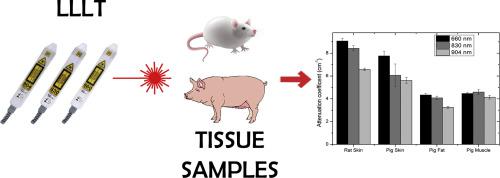Journal of Photochemistry and Photobiology B: Biology ( IF 3.9 ) Pub Date : 2020-05-22 , DOI: 10.1016/j.jphotobiol.2020.111914 Rafael Inácio Barbosa 1 , Elaine Caldeira de Oliveira Guirro 2 , Luciano Bachmann 3 , Hugo Evangelista Brandino 2 , Rinaldo Roberto de Jesus Guirro 2

|
Background:
In recent decades, low-level laser therapy (LLLT) has occupied a prominent position and has been studied in various fields of knowledge, and your effects have been widely observed in studies about numerous tissues, such as tendons, peripheral nerves, cutaneous tissue, bone, and muscle, in different fields of knowledge. Purpose: To analyze the power transmitted by low-level laser therapy (LLLT) to different tissue samples by using distinct wavelengths. Methods: Skin samples of rat (n = 7, 1.17–1.63 mm) and pig (n = 10; 1.20–2.30 mm); pig fat (n = 10; 2.71–14.01 mm) and pig muscle (n = 10; 1.91–8.91 mm) were analyzed and interposed between the emitter and the power analyzer sensor. All the samples were irradiated sequentially three times, at five equidistant points and average power levels of 35.34(±1.03), 32.40(±0.70), and 42.32(±0.82) mW, for the wavelengths 660, 830, and 904 nm, respectively. Transmitted radiation was measured with a power analyzer connected to a laser emitter. Statistical analysis was performed with a Shapiro-Wilk test followed by ANOVA with Tukey's post hoc test, with a significance level of 5%. Results: The transmitted power of LLLT on skin, fat, and muscle of tissues decreases with the increase of thicknesses, presenting minor attenuation on rat skin, pig fat, and pig muscle for 904 nm. The pig skin has the slight attenuation for 830 nm. Conclusion: The LLLT should be applied after considering the transmission loss taking place in different anatomical structures, following the Beer-Lambert law and attenuation coefficient presented for more practical application in many fields.
中文翻译:

分析生物组织样品中波长为660、830和904 nm的低水平激光透射率。
背景:
近几十年来,低水平激光疗法(LLLT)占据了突出的位置,并且已在各个领域进行了研究,并且在许多组织(例如肌腱,周围神经,皮肤组织,骨骼和肌肉,处于不同的知识领域。目的:通过使用不同的波长来分析低水平激光疗法(LLLT)传输到不同组织样本的功率。方法:大鼠(n = 7,1.17-1.63 mm)和猪(n = 10; 1.20–2.30毫米);分析猪脂肪(n = 10; 2.71–14.01 mm)和猪肌肉(n = 10; 1.91–8.91 mm),并将其置于发射器和功率分析仪传感器之间。所有样品分别在五个等距点依次照射三遍,平均功率水平分别为660、830和904 nm,分别为35.34(±1.03),32.40(±0.70)和42.32(±0.82)mW。 。使用连接到激光发射器的功率分析仪测量透射的辐射。统计分析采用Shapiro-Wilk检验,然后采用ANOVA进行Tukey事后检验,显着性水平为5%。结果:LLLT在组织的皮肤,脂肪和肌肉上的传输功率随厚度的增加而降低,在904 nm处对大鼠皮肤,猪脂肪和猪肌肉的衰减较小。猪皮在830 nm处有轻微衰减。结论:应考虑到不同解剖结构中发生的传输损耗,并遵循比尔-朗伯定律和衰减系数,以便在许多领域中更实际地应用,才应使用LLLT。











































 京公网安备 11010802027423号
京公网安备 11010802027423号